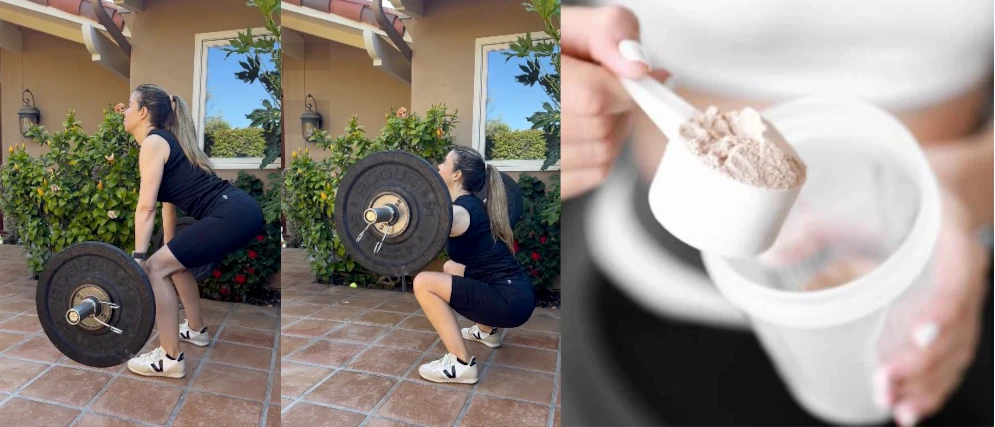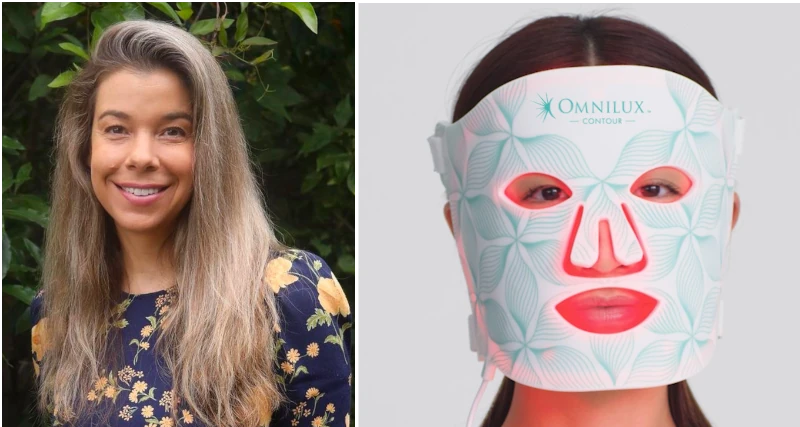Before digging into the specifics of Dr Rhonda Patrick’s diet, let’s look at her core diet strategies:
- Time Restricted Feeding – Rhonda typically eats within an 8 or 10 hour eating window – depending upon her schedule that day
- Cutting out refined grains & sugar – Rhonda avoids simple carbohydrates, such as white bread, rice, pasta, chips, cakes, cookies etc. Resulting in her diet being primarily vegetables, fruit, meat & fish. She does consume some wholegrains such as oats (for their beta glucan content), quinoa and wholegrain sprouted bread.
- Micronutrient rich smoothies – Rhonda uses these as a core method of increasing her raw vegetable intake, enriching her diet with micronutrients and pre-biotic fibre.
- Sulforaphane – Rhonda consumes sulforaphane on a regular basis – both through broccoli sprouts and supplements. We’ll discuss the many health benefits below.
- Nutrigenomics – Rhonda integrates data about her DNA into her diet decisions. For example, certain DNA mutations mean that some people need to supplement additional folate, others need to reduce saturated fat & replace with polyunsaturated, etc. In the section below we will discuss examples of how this data could affect your diet choices + how to get this data for yourself & take action on it.
In addition to the above core diet strategies, Rhonda orchestrates her meals such that she hits the key vitamins and minerals she needs for optimal health. Below we’ll look in greater detail at her core diet strategies, and then dig into the specifics of her breakfast, lunch and dinner.

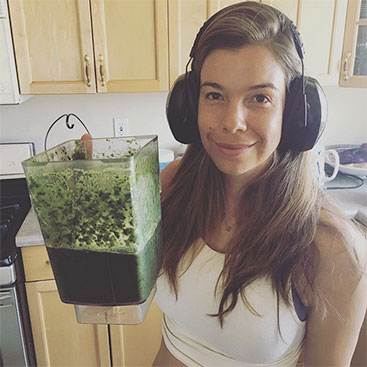
1. Time Restricted Feeding Overview
You might have heard of intermittent fasting? Time restricted feeding is the same idea, but is the scientific term used by Satchin Panda and his team at the Salk Institute – from whom Rhonda draws her research. Their studies have uncovered huge health benefits using time restricted feeding in animals, and they’re currently researching further to understand which of these benefits apply equally to humans. Satchin wrote a book called The Circadian Code which covers the subject in depth.
Time Restricted Feeding Benefits in Mice
A key study from 2012 (source) looked at feeding a high fat diet to two groups of mice. Both groups had access to the same amount (and type) of food. However the first group could access the food at any time of the day, whereas the second group only had access for 8 hours per day. The benefits for the mice with only 8 hour access were:
- Lower body fat
- Lower inflammation
- Better motor co-ordination
- Better glucose tolerance, and less leptin resistance
- Healthier liver blood tests
Time Restricted Feeding Benefits in Humans
A 2018 human study did a 5-week time restricted feeding trial in 8 men with pre-diabetes. They randomly assigned the participants either an 6-hour eating window, or a 12-hour eating window. After 5 weeks of one diet, each participant crossed over to do 5 weeks of the other. The 6-hour eating window achieved some beneficial results:
- Improved insulin sensitivity
- Decreased blood pressure
- Decreased oxidative stress

Rhonda’s Time Restricted Feeding Regimen
Rhonda’s current window of time restricted feeding is 8-10 hours. Dr Satchin Panda’s research has shown that most people eat on a 15 hour window (!) For example, they might have a cup of coffee at 7am, and then have their last bite of food at 10 o’clock at night.
Rhonda notes that the eating window starts the moment you put anything into your body that isn’t water, that even includes tea or coffee! Food and xenobiotic compounds, such as the caffeine in coffee, activate metabolic enzymes in your liver and gut, and those enzymes are on a “clock”. This is because humans are diurnal (active during the day, and asleep at night) – and our evolution has led to us having cells that are optimized towards 12 hours of day time activity.
Whilst eating within the 12 hour (day time) clock, we metabolize glucose, amino acids, fatty acids optimally. However, past that 12 hour clock, say we’re eating at night, that’s when our metabolism in general no longer works as well. For example, our insulin sensitivity increases, and our body switches to the storing of fatty acids, rather than using them for fuel.
For more of Rhonda discussing Time Restricted Feeding, see the snippet below from her interview on the Joe Rogan Experience episode #901. She also has 3 in depth interviews with Dr Satchin Panda (Interview 1 from 2016, Interview 2 from 2017 and Interview 3 from 2021).
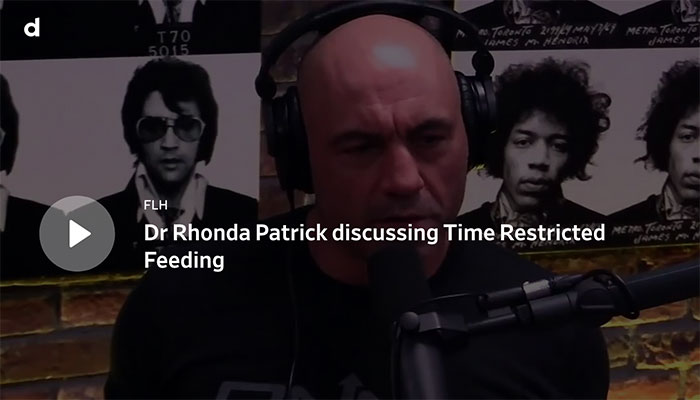
^ Short video clip of Rhonda discussing time restricted feeding
2. Cutting Out Refined Sugars & Refined Carbohydrates
Rhonda suggests that the one dietary change that would make the biggest improvement to someone eating the “Standard American Diet” would be to cut out all refined sugars.
When we talk about refined sugars, we’re talking about the sugar that gets added to sodas, candy, cookies, cake etc.
Regular consumption of refined sugar can lead to a plethora of negative health consequences, including:
- Weight gain
- Type 2 diabetes
- Atherosclerosis
- Accelerated ageing + more.
One study found that the standard 20-ounce serving of soda, consumed daily, resulted in telomere ageing of approximately 4.6 years (source). The below video is a snippet from a podcast with Joe Rogan (JRE #1054), discussing the effects of refined sugar on health.

^ Short video clip of Rhonda discussing refined sugars
3. Micronutrient Rich Smoothies
Rhonda is a huge advocate of smoothies. They’re a great way to consume large amounts of vegetables quickly and easily. No culinary skills required, simply wash them and throw them in a blender. If you kick the day off with a smoothie, even if the rest of your meals are sub-par in terms of health, you’ve at least covered your ass in terms of consuming a good amount of healthy vegetables.
The main two things you’re getting with Rhonda’s smoothies are:
- Large amounts of what are called ‘essential micronutrients’ – vitamins and minerals that your body can’t synthesize from other things. If you don’t get adequate amounts your health may suffer. This is referred to as Triage Theory, and it’s discussed more in Ames, 2018.
- Pre-biotics – these are non digestible plant fibre that provides food for “good bacteria” to live and grow. Evidence is mounting to show that maintaining healthy gut bacteria is crucial to good health. For more info on the subject of healthy gut bacteria, Rhonda recommends the The Good Gut book, by Justin & Erica Sonnenburg – who were also on a podcast of hers.
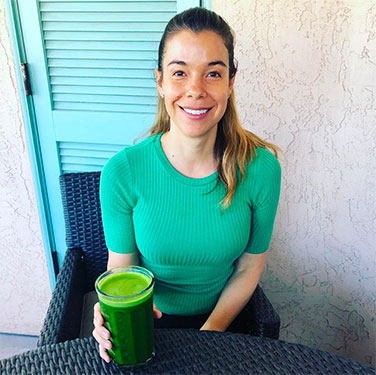
I’ve adopted this suggestion from Rhonda, and definitely recommend it. Vegetable smoothies are probably one of the easiest dietary adjustments to make that can have a huge impact on long term health.
In Rhonda’s “original” smoothie recipes she used to incorporate fruits like apple, banana and blueberries. However, after she used a blood glucose meter to track daily fluctuations in her glucose, she has reduced the amount of fruit in her smoothies. Opting for better blood glucose regulation over taste.
See further down this post for the types of smoothies she makes, including ingredient list.
4. Sulforaphane
Rhonda is a big fan of sulforaphane, a compound derived from brassica vegetables. It activates a pathway called NRF2 which increases the expression of a host of cell protective genes. She takes sulforaphane (in the form of broccoli sprouts added to her smoothie) 2 to 3 times per week. I’ve written here about how Rhonda sprouts her own broccoli seeds, what equipment she uses to do so, and what dose (weight of sprouts) she uses to get the optimal effect.

For more information on sulforaphane, see Rhonda’s deep dive video on sulforaphane. For a less technical, but potentially more engaging description on the benefits of sulforaphane, see the below snippet from Rhonda’s podcast with Joe Rogan on JRE #901:

^ Short video clip of Rhonda discussing Sulforaphane’s amazing health benefits
5. Nutrigenomics
Rhonda is a big proponent of nutrigenomics, the idea that specific patterns (SNPs) in our DNA illuminate how we as individuals handle certain foods in our diet.
Examples of genes that are noteworthy for diet choices include:
- MTHFR – can affect folic acid synthesis
- PPAR alpha – can affect fatty acid metabolism, particularly good to know if you’re embarking on a high fat diet
- FTO – certain variants predispose individuals to obesity in the context of a diet high in saturated fats, and low in polyunsaturated fats
Rhonda has talked previously about how she encouraged all her family to get their DNA checked, and upon learning that her mother had a mutation in MTHFR, that leads to poor synthesis of folic acid… she encouraged her mom to start supplementing methylated folate.
Possible Theory for the “Why” of Nutrigenomics
It is thought that our ancestors adapted to the food sources available in their local region. One example of this, is how certain human populations developed mutations in their DNA that lead to them still having the correct enzyme (lactase) to consume milk into adulthood. In Neolithic Scandinavians, only 5% of those sampled had a gene associated with lactase persistence in adulthood, vs 74% of the existing Swedish population1High frequency of lactose intolerance in a prehistoric hunter-gatherer population in northern Europe – Malmström et al. (2010). Suggesting that as humans moved from hunter gatherers to sedentary agriculture, we selected for genes that allow us to consume milk through adulthood. Of course we didn’t do this consciously per se, but through natural selection.
Why is this relevant? Well, firstly, many of us don’t live in the same circumstances that our ancestors did. Even if you are currently living in the same geographic location as your ancestors, it’s unlikely you’re eating the same things they did. Therefore, considering that we live in an “un-natural” food environment, it can useful to understand any dietary biases that your genetics are adapted for. That way we can adjust our diet to avoid any pitfalls we would otherwise be unaware of.
How to get your Nutrigenomics Data
To get your nutrigenomics data there are 3 simple steps:
- Purchase a DNA (SNP marker) testing kit, via providers such as 23andMe or Ancestry
- Spit in the plastic tube they provide you (yes, really), and post it back to them
- Once they have processed your data, export it into Promethease and/or Rhonda’s Genetic Tool
Once you have either report, you can begin learning more about your DNA.
23andMe vs Ancestry

There are quite a large number of DNA testing services available. However, to keep things simple, the major two are 23andMe & Ancestry. 23andMe actually offers some health related data within its dashboard, but to really make the most it, you’ll still need to export the data and analyze it via third party tools.
For the purposes of our nutrigenomics exploration, both 23andMe & Ancestry provide adequate SNP data to analyze in Promethease.
Currently Rhonda’s genetic tool supports both 23andMe and Ancestry – with both hovering around $99 each, depending on what promotions are on at any one time.
Rhonda talks more below on how nutrigenomics works:

Promethease vs Rhonda’s Genetic Tool
The simplest tool for analyzing your nutrigenomic data is Rhonda’s genetic tool. It has been configured to cover all the SNPs that she regularly talks about + more. The cost of processing your report is $25, but for Patreon subscribers of $15 or more, it’s included. As mentioned above, it is best optimized for analyzing 23andMe reports currently.
Promethease is a more comprehensive analysis tool. It utilizes the SNPedia.com database, and provides a comprehensive SNP analysis. Promethease will cover everything Rhonda’s tool analyzes + more. But the rub is that you will need to wade through its library to pick out the data points of interest.
I’ve used both tools, and appreciate them in their own ways. Promethease for its comprehensiveness (for example, it also covers disease risks), and Rhonda’s tool for its razor sharp focus on nutrigenomic SNPs.
Promethease currently costs $12 to run your report, and can handle reports from all the major DNA tests, including 23andMe, Ancestry, FamilyTreeDNA etc.
DNA Testing & Data Privacy
One very reasonable hesitation with genetic testing kits is the possibility that this data gets shared beyond the company you purchase it from. For example, health insurance companies might like to know if their customers have SNPs that increase the likelihood of cancer. In 2018, the major DNA testing services (including 23andMe & Ancestry) created a Privacy Best Practices for Consumer Genetic Testing Services policy (document link + 23andMe’s press release on it). This provides some reassurance, but doesn’t stop services from anonymizing customer data and selling it
We first saw this with pharmaceutical company GlaxoSmithKline purchasing a $300m stake in 23andMe, to use their data to help identify new drug targets (article link).
What we don’t yet have are guidelines on how to anonymize the data thoroughly and correctly, thus we run the risk of this data being de-anonymized.
The other risk is that the company gets bought, and the data passes hands that way. This happened recently with Ancestry.com being bought by private equity firm Blackstone (article link).
Personally I took the risk to use 23andMe back in 2011, before I had really thought about all the possible future implications. However, in 2021, digital privacy is more important than ever, and wanted to give some warning of the risks.
Rhonda’s Typical Breakfast, Lunch & Dinner
Now that we’ve covered Rhonda’s core diet strategies at a high level, we’ll zoom in and look at specific examples of what she eats, and why. Part of this info comes via a Tim Ferriss podcast interview (link), and part is via more recent updates.
Breakfast
#1 – Scrambled Egg, Satueed Kale & Garlic with Grapefruit
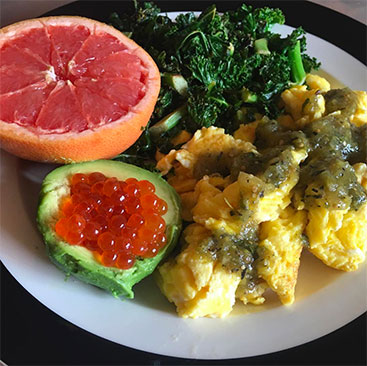

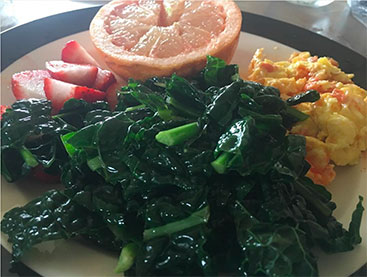
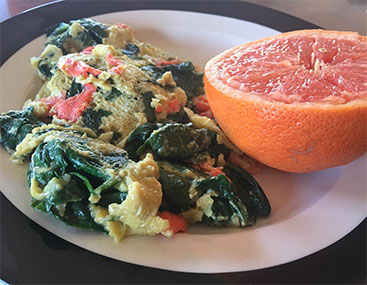
One of Rhonda’s go to breakfasts is scrambled eggs, sautéed kale + grapefruit. Clicking on the meal images will take you to Rhonda’s Instagram page where she explains in more detail the rationale behind the ingredients.
Ingredients:
- Scrambled eggs
- Sauteed Kale & Garlic (topped with salt, olive oil and mustard powder)
- Grapefruit
- Avocado oil for cooking the eggs and sautéing the kale
- Tomatillo salsa (to give the eggs more flavor)
Optional Variations:
- Add an avocado filled with salmon roe (see first image above)
- Rather than scrambling eggs and sautéing kale separately, in the last image she’s opted to mix kale plus salmon into her scrambled eggs
- Scrambled eggs topped with salmon roe
#2 – Mixed Nuts & Berries Bowl
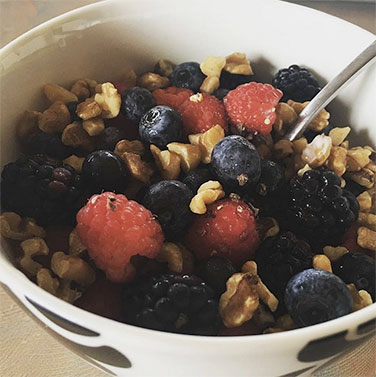

As a contrast to the above cooked breakfast, Rhonda also likes to mix nuts and berries together to form a muesli like cereal. Whilst Rhonda doesn’t eat wheat, she does eat oats up to a couple times per week for their beta glucan content. Using nuts and berries as a base, she then tweaks it by adding things like pomegranate, flaxseed, cacao nibs and almond butter.
Ingredients:
- Chopped nuts – including pecan, macademia & walnut
- Mixed berries – blueberries, blackberries raspberries
- Hydrolyzed collagen powder (Rhonda uses Great Lakes brand)
- Coconut milk (unsweetened)
Optional Variations:
- Adding pomegranate in with the blueberries
- Adding Greek yogurt with a sachet of high strength probiotic (Rhonda uses Visbiome brand)
- Adding flaxseed (for omega-3 ALA + fibre content)
- Adding shredding coconut
- Adding Cacao nibs and/or almond butter
Lunch
Micronutrient Rich Smoothies


Whilst lunch for many is a sandwich or cooked meal, Rhonda tends to opt for a micronutrient rich smoothie.
She has 2 “well-known” smoothie recipes that are widely circulated online (see below). However, more recently, she has cut back on the fruit in her smoothies, after experimenting with a continuous blood glucose monitor, and finding that the fruit elevated her blood glucose higher than she wanted. Whilst she hasn’t (yet) listed all the new smoothie recipes she’s using, she has described a couple of low/zero fruit smoothies she uses:
- Spinach (1 bunch), 4 large celery stalks, parsley (1 bunch), cucumber (1), small lemon (1), fresh ginger to taste – serving size: 2 people (source)
- Kale, beet, garlic, ginger, bell pepper, carrot, lemon (source)
The key takeaway is that by blending vegetables you can get an easy boost to your overall micronutrient intake.
Below are the recipes for Rhonda’s 2 most well-known smoothies, based on her YouTube videos (see smoothie 1 and smoothie 2).
They are sized for 2 people, as Rhonda makes for both her and her husband. Thus if you’re making them just for yourself, halve the quantities or consume in 2 sittings.
Base ingredients:
- Kale (8 leaves)
- Rainbow Chard (2 leaves and stems)
- Spinach (2 cups)
- Carrot (1 large)
- Tomato (1)
- Apple (1)
- Frozen organic blueberries (1-2 cups)
- Avocado (1)
(technically “smoothie 1” uses slightly more chard, spinach and carrots than “smoothie 2”)
Then “smoothie 1” adds:
- Banana (1)
- Unsweetened flax milk (3 cups ~710 ml)
- 1 tall shot glass of flaxseed (optional)
Or “smoothie 2” adds:
- Lemon (1)
- Celery (2)
- Parsley (8 pieces)
- Hydrolyzed collagen powder (Rhonda uses Great Lakes brand) (1/4 cup)
- Water (2 cups of water)
Additional smoothies (with fruit) Rhonda has discussed:
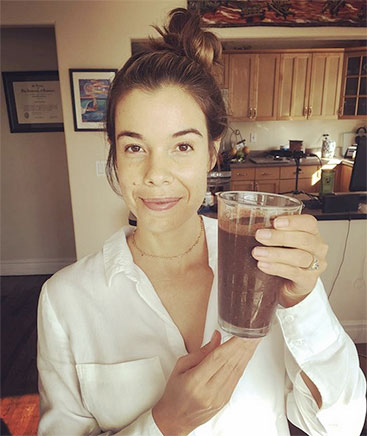
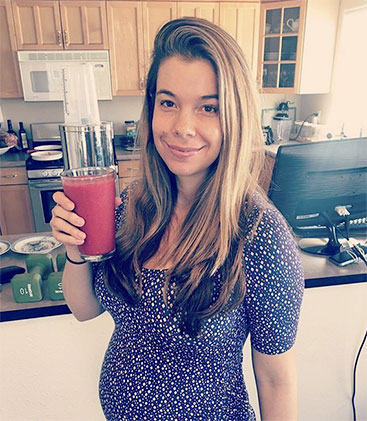
Avocado Topped with Salmon Roe


As well as aiming to consume sufficient omega-3 fatty acids, Rhonda also aims to consume omega-3 fatty acids in “phospholipid” form. In this way, the omega-3s are more easily absorbed by the body. Wild Alaskan salmon roe is a great source of phospholipids, and thus Rhonda combined them with avocado to make a healthy (light) meal.
Ingredients:
- Avocado, topped with lemon juice
- Wild Alaskan Salmon Roe (Rhonda has said previously she bulk buys hers from Vital Choice)
Dinner
#1 – Baked Salmon & Greens


Rhonda aims to eat salmon 2-3 times per week, which is what the American Heart Association recommends. Specifically, they suggest adults consume 500 mg per day of EPA and DHA. Which is ~2-3 servings of fatty fish per week (~8 oz). However, the average intake in Western society is only ~135 mg per day (which is about 2 servings of fish per month)
Ingredients:
- Baked salmon
- Assorted vegetables – often kale and spinach. Last image shows her adding avocado
#2 – Chicken Legs & Vegetables
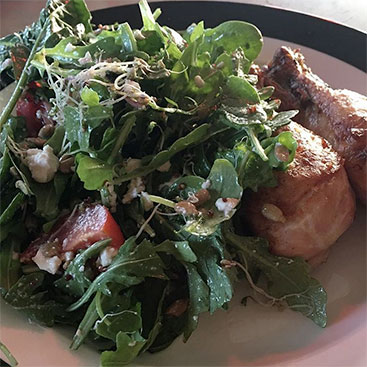

Ingredients:
- Grilled chicken legs from pasture raised chickens, which has some cartilage – high in collagen, proline and glycine
- Green vegetables, such as salad or sauteed kale
- Kimchi – for prebiotics and isothiocynates – on JRE #1474 she noted particularly liking Mother In Law’s kimchi brand
#3 – Chicken Bone Soup with Vegetables


Rhonda makes a chicken bone soup that intrinsically has the same benefits as the hydrolyzed collagen powder she sometimes supplements; high in proline, glycine and collagen.
Ingredients:
- Chicken bones & chicken
- Vegetables: Kale, carrots, sweet potato, celery, onion, garlic
- Flavouring: Pepper, rosemary, black pepper, Himalayan sea salt
#4 – Grass Fed Beef
Rhonda has a grass fed fillet steak a few times per month, which is a good source of vitamin B12, Iron, and Zinc. Around 16% of all menstruating women are actually iron deficient. For the vegetarians out there… it has been recommended to take in around twice the RDA for iron, since iron which is bound to phytate in plant sources and is ~2-times less bioavailable. One of the sources Rhonda has mentioned buying her beef from is US Wellness meats, as they only sell 100% grass-fed beef.
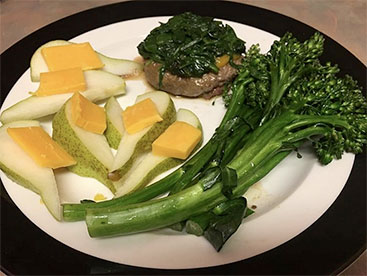

Ingredients:
- Grass fed beef – fillet steak or otherwise
- Green vegetables – such as kale or broccoli
- In the image above, Rhonda’s combined pear with cheese. Pears contain catechin and proanthocyanidins, which both activate antioxidant and anti-inflammatory genes. The pears also contain prebiotic fiber to feed the gut bacteria. The aged cheddar cheese contains vitamin K2 (which prevents calcification of arteries), fat, and some calcium.

Rhonda’s Ketogenic Diet Experiment
As of August 2021, Rhonda is experimenting with a ketogenic diet. The backstory is that she found her cognitive performance was improved whilst in a fasted state. So much so, that she now opts to do podcasts and other public speaking events whilst fasted. She finds it particularly improves her mental recall and ability to verbally articulate ideas. She hypothesizes that part of the reason for this could be due to running on ketones, which is something that also happens whilst on a ketogenic diet. Therefore she’s interested in the ketogenic diet as a way to capture some of the benefits she experiences whilst fasting – but for more of the day.
The ketogenic diet that she’s doing is largely based on polyunsaturated and monounsaturated fat sources. This means she’s eating a lot of:
- Nuts
- Avocados
- Olive oil and olives
- Fish – specifically salmon, mackerel and sardines
This is opposed to a ketogenic diet high in butter, cheese and other dairy products – which are higher in saturated fat.
She also continues to eat meat, such as steak, chicken or ground beef.
Asked about her stance on organ meats (via her August 2021 Q&A), she says that she includes them in her diet about once per week. She likes a ground beef from US Wellness meats (link) that has heart, kidney and liver ground in with it. That way she can cook can cook it up in a sauce or a chilli, and members of her family that wouldn’t normally eat organ meats don’t notice the inclusion.
She’s unclear if she will always eat this way – but for now the experiment is in progress.

Drinking Water
We’ve covered Rhonda’s diet in detail – now lets move on to the other thing we all consume on a daily basis; water.
When asked what Rhonda uses to filter her water, she replied on Twitter saying a Berkey filter.

That Tweet was from 2018, but in her December 2021 Q&A she confirmed she still preferences Berkey filters.
The Berkey water filters are freestanding, gravity fed filters that have been tested to remove a whole host of things, including:
- Chlorine
- Heavy metals
- Pesticides
- Even viruses (as tiny as they are)
Sleep
Scientists used to ask the question “why do we sleep?” – looking for 1 big answer. However, it’s now understood sleep improves every process in the human body.
In February, Rhonda released a podcast interviewing sleep scientist Matthew Walker. If you haven’t listened to it already, I highly recommend it. Off the back of that, she has talked about the steps she takes to ensure good quality sleep.
1) Get Early Bright Light Exposure
Rhonda aims to get 30 mins to 1 hour of bright light exposure in the mornings. This gives your circadian clock an anchor for the morning.

2) Avoid Blue Light After Sunset
Whilst daylight in the morning is good, exposure to blue light in the evening can suppress melatonin release2Action spectrum for melatonin regulation in humans: evidence for a novel circadian photoreceptor – Brainard GC et al (2001). Releasing melatonin in the evening is natural, and it signals the need to sleep. However if we suppress the melatonin, we suppress the feeling of needing to sleep, resulting in later sleep times.
To tackle this problem in Rhonda’s last home she swapped out the regular lights for Philips Hue bulbs. They can be controlled through software on your phone to only emit red light in the evenings, avoiding the wakeful blue light. She says this results in feeling sleepy earlier, something even friends visiting had commented on.

When she moved to a bigger place, it wasn’t feasible to switch out everything to Phillips Hue, so instead she opted for adding dimmers to rooms that didn’t have them. She said this helps a lot.
An alternative to changing your bulbs are light blocking goggles. However compliance can be worse, as you have to remember to put them on each evening.
3) Avoid coffee in the afternoon
Rhonda drinks a coffee in the morning, but makes a rule of not drinking any in the afternoon, as the caffeine affects sleep quality when consumed later in the day. If she needs an afternoon pick-me-up, she will opt for her nootropic drink instead – which contains far less caffeine.

4) No Screen Time 2 Hours Before Sleep
Rhonda aims to avoid screen time (phone, computer, ipad) 2 hours before sleep. Rather than it being about light this time, she says that isn’t the key part, because we can use applications on our devices to reduce the blue light. Instead, these devices increase anxiety and reduce relaxation, and that’s what we’re trying to avoid. Things like emails, social media and news headlines can all increase anxiety and alertness before bed.
Something she has taken to is ordering science publications; such as New Scientist, and reads them in the evening. Whilst that may not be everyone’s cup of tea content-wise – the general principle of reading offline content is likely to help, be it fiction, fantasy etc.
5) Time Restricted Eating
Rhonda aims to finish eating 3 hours before bed. This reduces digestion whilst sleeping, which can improve sleep quality.
6) Blackout Curtains / Dark Room
Even a little bit of light can disrupt sleep, so Rhonda takes steps to ensure her bedroom is dark at night. Blackout curtains or sleep masks can be a good solution, especially if street lights or vehicle headlamps are a problem. Similarly, noise from the street or neighbors can also interfere with sleep – for which high quality earplugs work for some people. A complimentary (or alternative) can be the use of artificial “white noise” to reduce unwanted disturbances. There are stand-alone white noise machines (example), or there are phone apps which do a similar thing (such as Deep Sleep on Android, or White Noise Lite on iPhone)

7) Sleep in a Cool Room
Our bodies naturally drop their core temperature at night, and having a warm room makes this harder.
The Cleveland Clinic suggests 60 to 67° F (15 to 19° C) is the ideal temperature range. A colder room is easier to modulate with blankets, whereas with a hotter room, there’s only so much clothing you can take off.
Rhonda resides in a warm part of the world (San Diego, CA), and thus has taken to using an Eight Sleep cover.
It goes over your existing mattress and circulates water to maintain the desired temperature. Once a temperature is set, the cover will maintain it throughout the night, even as your room and body temperature fluctuate.
It’s not just Rhonda who’s a fan, I believe fellow podcasters Peter Attia and Tim Ferriss also use them.

^ Eight Sleep splits the bed in two, so partners can enjoy different temperatures
Side Note: Melatonin
Melatonin is a hormone produced by our bodies to regulate the sleep-wake cycle. We produce melatonin as the sun sets and night sets in, and we reduce production as the sun rises and our body preps for wakefulness.
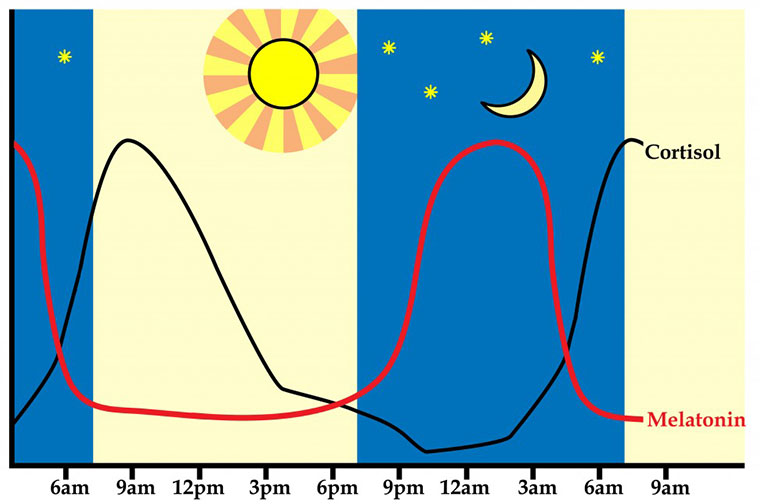
Rhonda suggests that melatonin can be useful as we age (particularly for those 50+), because over time our natural production decreases.
The aspect of melatonin production decreasing with age is important (see this study for more discussion). We know that good sleep is absolutely crucial to overall health, so if we can supplement melatonin and measure a noticeable positive impact on sleep, that’s a big (easy) win. This can be coupled with exercise, which also improves sleep quality (for both younger and older people).
Rhonda was previously using a low dose melatonin supplement (Life Extension 300 mcg), based on this research by MIT.
She has since switched to taking a high dose (9mg), which she says helps keep her night terrors at bay. See this section of her recent Joe Rogan interview for where she mentions it.
The specific figure of 9mg likely comes from a string of research papers on sleep disruption, where 9mg was the dose used.
During the interview she didn’t specifically mention which specific brand she’s using, but her go-to brands with relevant doses include Life Extension – Melatonin 3mg.
Rhonda’s Dosage: 9mg / nightly

Rhonda’s Supplements
Whilst Rhonda strives to meet all her micronutrient needs through diet, she also takes supplements daily in order to cover all bases.
Part of her rationale for supplements comes from the work of one of her mentors; Bruce Ames. His “triage theory” informs us that even moderate micronutrient deficiency over time can diminish our bodies’ ability to repair itself. See Ames, 2018 for more info.
For the list of supplement Rhonda takes, see this article.
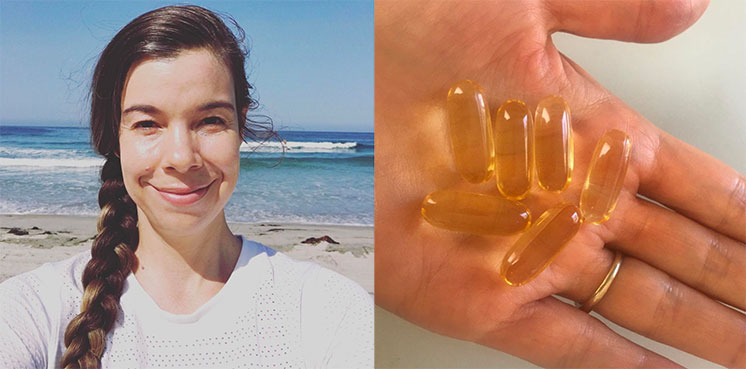
Sauna
Rhonda started using the sauna when she was in grad school, as a way to elevate her mood and reduce anxiety whilst she was working long hours to complete her PhD. What started as a simple enjoyment, later turned into a research area, as it became clear that the benefits of sauna use go far beyond just mood enhancement. Rhonda explains in her lengthy post on saunas, the benefits include:
- Detoxification
- Improved cardiovascular health
- Decreased all-cause mortality
- Improved cognition

In response to a question on Instagram (link) about which sauna she uses, Rhonda mentioned having a Finnleo PS44, with upgraded 2.2KW heater.

She noted in a separate Instagram post that she chose it because it can reach high temperatures using a regular electrical outlet, and has a number of useful features, including water on rocks.
Since then she mentioned on a Q&A she has moved to a Nordic sauna (possibly from these guys – sauna.com) – but didn’t mention a specific model.
How hot is ideal for a sauna?
Well, the major Finnish studies (KIHD)3Association Between Sauna Bathing and Fatal Cardiovascular and All-Cause Mortality Events – Laukkanen et al (2015) which found a dose-dependent reduction in all-cause mortality, involved saunas heated to at least 78.9°C (174°F) for 20 minutes. Note that hot sauna use is contra-indicated for some people (examples here).
Dental Health
Given that no-one likes getting dental work done, and we all appreciate having a nice smile, I think it’s fair to say that dental health is crucial. In addition to flossing twice per day, Rhonda mentioned in her August 2021 Q&A that she also uses a Waterpik. These are devices that use high pressure water to clean the areas around your teeth and gumline. She said that after discussion with her hygienist, using the waterpik, in addition to flossing, appeared to improve her dental hygiene.
Xylitol
To Rhonda’s surprise, she was able to reverse 2 dental cavities (identified via x-ray) by chewing xylitol gum regularly. See this section of her Joe Rogan interview for the full story.
Studies show xylitol can reduce plaque and saliva levels of streptococcus mutans, a bacteria commonly found in the mouth, which contributes significantly to dental cavities4Xylitol Chewing Gums and Caries Rates: A 40-month Cohort Study – Hujoel et al. (1995)5Xylitol, Sweeteners, and Dental Caries – Marilynn et al. (2006)..
To get a ballpark figure on the amount of xylitol needed for dental cavity protection, one paper suggests 6-10 grams per day, and another suggests 4-9 grams per day.
Sometimes sweeteners can cause stomach upset, and with Xylitol that seems to kick in around ~100g/day for adults and ~45g/day in children. With most adults comfortably6The effect of xylitol on dental caries and oral flora – Khandelwal et al. (2014) tolerating 40g/day.
A trick to finding a good xylitol gum, is to look for one that lists xylitol as its first ingredient (and then doesn’t list other sweeteners). If they do that, they’ll typically have 1 gram of xylitol per piece.
Rhonda has mentioned on Twitter (source) preferencing Pur gum:

Similarly, Xlear’s Spry gum is high in xylitol, at 0.9g of xylitol per piece. So there are at least a couple good options.
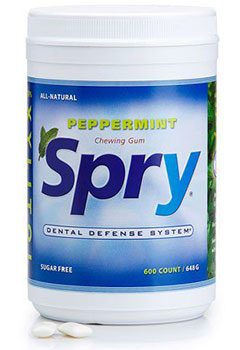
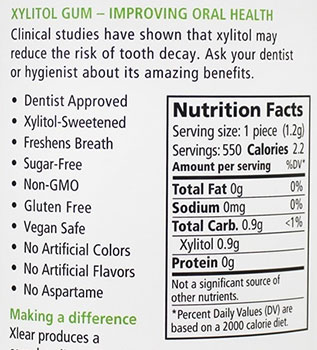
Exercise Routine
Each week Rhonda aims to include:
- Endurance Training – specifically Rhonda opts for Running
- High Intensity Training – specifically Rhonda opts for Spinning classes (stationary bike class) or Squat Jumps
- Resistance/Strength Training – specifically Rhonda opts for lunges, squats & other weight lifting exercises
- Stretching/Flexibility – specifically Rhonda opts for yoga and ballet exercises
Rhonda explains that the top 3; endurance, high intensity & resistance training are necessary to stave off muscle aging.
This is important to realize, because many of us get comfortable in exercise routines of limited variety. If we get comfortable just doing endurance training like running or cycling, then we might miss out on the muscle preserving benefits of weight lifting. Vice-versa, if we only do weight lifting – we may miss out on the mitochondrial benefits of endurance training. Below are specific benefits of each type of exercise:
Endurance Training – Prevents age related decline in mitochondrial respiratory capacity – helping your muscle cells produce ATP similar to your younger self
High Intensity Training – Boosts mitochondrial biogenesis – increasing the number of young, healthy mitochondria your body makes
Resistance/Strength Training – Maintains or increases muscle mass, strength & power – all of which decline without training
For more of Rhonda on exercise & its benefits, see this longer post – Rhonda Patrick Exercise – Routine and Recommendations.
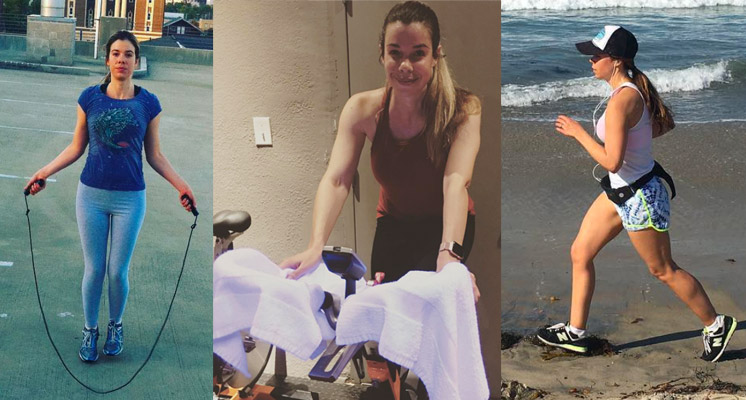
Closing Words
Whilst this post is long, hopefully you’ve found some of it useful for your own life. If it all seems a bit much, and you only take away one thing from the post, Rhonda has previously mentioned that cutting out refined sugars will yield the largest dietary health benefit.
If you value the research and content that Rhonda is putting out, consider signing up become a premium member on her site. Firstly, this crowd sponsored support allows her to continue to work independently, without being reliant on sponsors or grants. Secondly, premium members get a number of exclusive benefits, including members only emails, monthly Ask Me Anything live streams and open access to use her genetics reports.
In case they’re of value, here are some further posts I’ve written on Dr Rhonda Patrick related content:
- A relatively comprehensive list of supplements that Rhonda has discussed taking, some daily, some for specific use-cases (link)
- As mentioned above, a comprehensive look at both Rhonda’s exercise routine + the science behind exercise benefits (link)
- Notes on many of the key things Rhonda has discussed about pregnancy & baby health – based on her journey into motherhood (link)
Post Change Log
For those curious, see this post for a log of the key changes to this article.
References
- 1High frequency of lactose intolerance in a prehistoric hunter-gatherer population in northern Europe – Malmström et al. (2010)
- 2Action spectrum for melatonin regulation in humans: evidence for a novel circadian photoreceptor – Brainard GC et al (2001)
- 3Association Between Sauna Bathing and Fatal Cardiovascular and All-Cause Mortality Events – Laukkanen et al (2015)
- 4Xylitol Chewing Gums and Caries Rates: A 40-month Cohort Study – Hujoel et al. (1995)
- 5Xylitol, Sweeteners, and Dental Caries – Marilynn et al. (2006)
- 6The effect of xylitol on dental caries and oral flora – Khandelwal et al. (2014)

